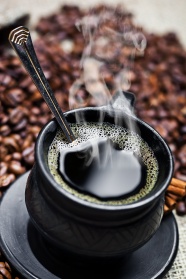Costa Rican coffee varieties Kadura, Kaduai
Full-bodied particles, ideal acidity, unique and intense aroma.
Tarrazu, Costa Rica, is one of the world's leading coffee producers, producing coffee with a light, pure flavor and pleasant aroma. Costa Rica's volcanic soils are fertile and well drained, making it the first country in Central America to grow coffee and bananas for commercial value. Coffee and bananas are the country's main exports. Coffee was introduced to Costa Rica from Cuba in 1729, and today its coffee industry is one of the most organized in the world, producing up to 1700 kilograms per hectare. Costa Rica has a population of 3.5 million, but coffee trees number 400 million, and coffee exports account for 25% of the country's total exports. Costa Rica also benefits from the Turrialba of the Central American Agricultural Research Institute (IAAC), an important international research center, established in Tarasu.
Costa Rican coffee production
Costa Rican coffee production
Costa Rican coffee beans
Costa Rican coffee beans
High-quality Costa Rican coffee is known as "extra hard" and can grow at altitudes above 1500 meters. Altitude has always been a problem for coffee growers. Coffee beans are better at higher altitudes, not only because higher altitudes increase the acidity of coffee beans and thus enhance flavor, but also because lower night temperatures at higher altitudes cause trees to grow slowly, thus making coffee beans more flavorful. In addition, due to the high altitude drop caused by sufficient rainfall, coffee tree growth is also very favorable. However, while there are many advantages to growing coffee at higher altitudes, the additional transportation costs associated with it must be taken into account, which may well make coffee production unprofitable. Costa Rican coffee has adopted new technologies to increase efficiency, including the use of "electric eyes" to select beans and identify beans of irregular size.
Tarasu is located south of the country's capital, San José, and is one of the country's most prized coffee plantations. La Minita Tarrazu coffee is locally famous but produced in limited quantities, about 72600 kilograms per year, grown on land called La Minita, owned by the last three generations of the McAlpine family in England. In fact, the land produces more than 450 tons of coffee per year. But Tara Sulamita is grown without artificial fertilizers or pesticides, and is harvested and picked entirely by hand, to avoid some of the damage done to the beans by air-jet sorting.
Other coffees worth mentioning are Juan Vinas (PR), H.Tournon, Windmill (SHB), Monte bello and Santa Rosa. Fine coffee is grown in Geredia and the Central Valley. Another striking coffee is Sarchi (one of the five towns that represent Costa Rica's "coffee route"), which grows on the slopes of Poas Volcano, 53 kilometers from San Jose. Saatchi was founded in 1949 and has 30770 hectares of land to grow sugar cane and coffee. The area is also known for its handicrafts, attracting tourists from all over the world.
The country's coffee industry, formerly controlled by Instituto del Café de Costa Rica (ICAFE), has been taken over by the Official Coffee Council (Oficina del Café). Among coffee exports, those deemed substandard are colored with blue vegetable dye before being recycled for domestic sale. Coffee consumed domestically (dyed blue or undyed) accounts for about 10% of total production, and local coffee consumption per capita is twice that of Italy or the United States

Important Notice :
前街咖啡 FrontStreet Coffee has moved to new addredd:
FrontStreet Coffee Address: 315,Donghua East Road,GuangZhou
Tel:020 38364473
- Prev

Costa Rican coffee processing methods Red honey processing
Full-bodied particles, ideal acidity, unique and intense aroma. Tarrazu, Costa Rica, is one of the world's leading coffee producers, producing coffee with a light, pure flavor and pleasant aroma. Costa Rica's volcanic soils are fertile and well drained, making it the first country in Central America to grow coffee and bananas for commercial value. Coffee and bananas are the country's staple foods.
- Next

Boutique coffee Salvadoran coffee features introduction to Salvadoran coffee
Unique, mild-tasting coffee. ElSalvador is one of the small countries in Central America with a dense population. The flavor of its coffee is characterized by excellent balance. Today, this coffee accounts for 40% of the country's exports. 35% of the extra hard beans of the best coffee are exported to Germany from January to March. In the early 1990s, guerrilla warfare greatly damaged the country's national classics.
Related
- Does Rose Summer choose Blue, Green or Red? Detailed explanation of Rose Summer Coffee plots and Classification in Panamanian Jade Manor
- What is the difference between the origin, producing area, processing plant, cooperative and manor of coffee beans?
- How fine does the espresso powder fit? how to grind the espresso?
- Sca coffee roasting degree color card coffee roasting degree 8 roasting color values what do you mean?
- The practice of lattes: how to make lattes at home
- Introduction to Indonesian Fine Coffee beans-- Java Coffee producing area of Indonesian Arabica Coffee
- How much will the flavor of light and medium roasted rose summer be expressed? What baking level is rose summer suitable for?
- Introduction to the characteristics of washing, sun-drying or wet-planing coffee commonly used in Mantenin, Indonesia
- Price characteristics of Arabica Coffee Bean Starbucks introduction to Manning Coffee Bean Taste producing area Variety Manor
- What is the authentic Yega flavor? What are the flavor characteristics of the really excellent Yejasuffi coffee beans?

